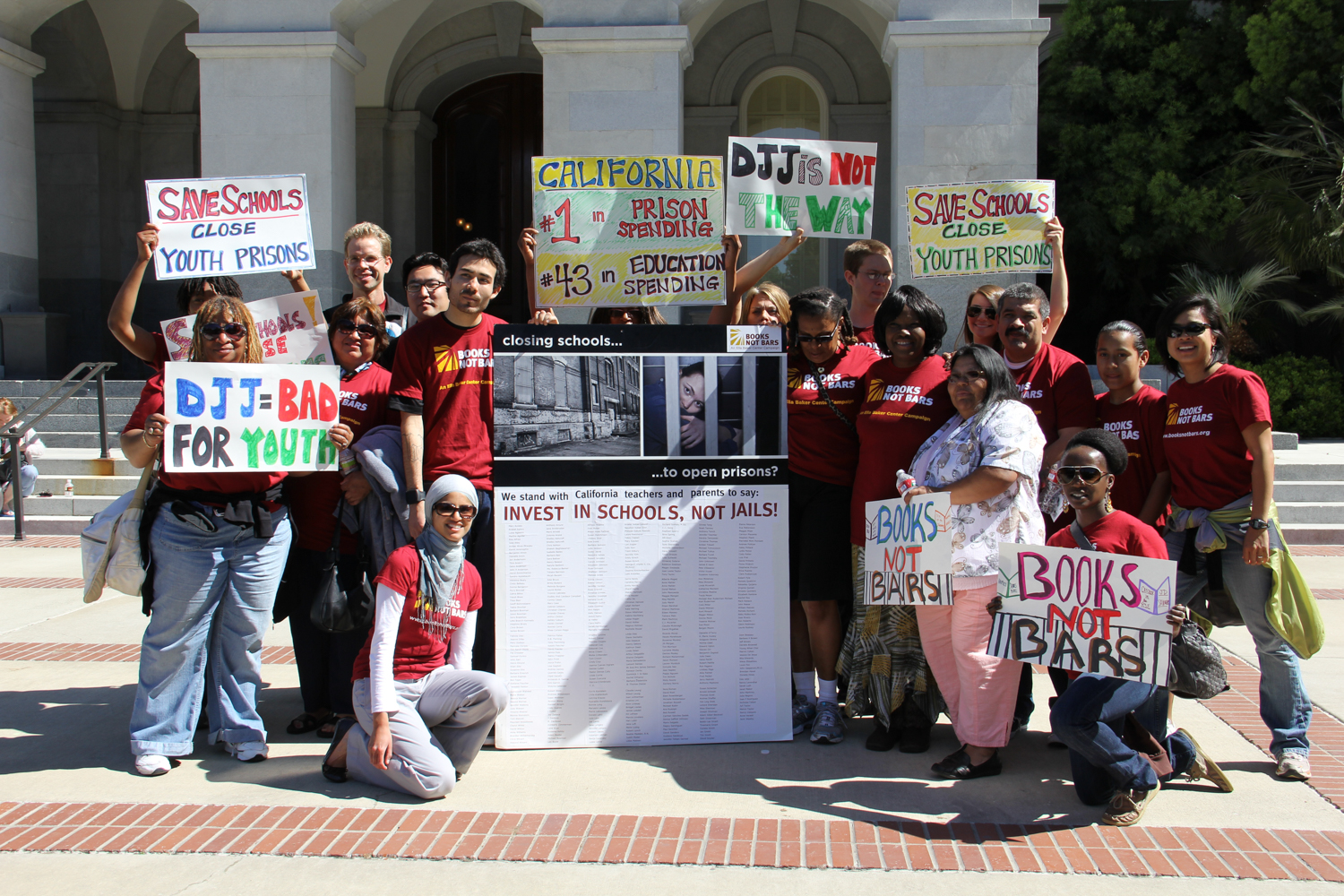Community
Closing Youth Prisons Is Not Enough
But without a plan to invest in and institute a restorative justice framework, most of that money might find its way back into local youth jails rather than into treatment and rehabilitation.

COMMENTARY
As a parent who was involved in the juvenile system as a teenager, I know too well that children who are struggling should never be incarcerated and treated like criminals.
Instead, they should be cared for as young people in need of restorative help. This May, dedicated as National Mental Health Awareness Month, was the perfect opportunity to embrace human rights and racial justice by moving from a carceral system of punishment to a community-based health system of restorative care.
“We have a system in place that is not really focused on rehabilitation,” Los Angeles State Senator Sydney Kamlager told CalMatters in January. Unlike some states, we have not had a governing body in California to oversee trauma-responsive, culturally informed services for youth–the majority of whom are youth of color–in the juvenile justice system.
Fortunately, we in California finally have a chance to make a change. California Senate Bill 823, signed by Gov. Newsom last December, shuts down California’s Division of Juvenile Justice (DJJ) and redirects millions of dollars to counties to provide care and resources for young people. But without a plan to invest in and institute a restorative justice framework, most of that money might find its way back into local youth jails rather than into treatment and rehabilitation.
Sonya Abbott and her son Anthony Johnson can attest that a transformation is long overdue. When Anthony was 16, Sonya found a bag of Xanax in his back pocket. Believing that he intended to sell the drugs, she made the difficult decision to turn him in. At the time, she viewed her decision as a way to save her son’s life, and the lives of others. Now she says, “I feel like it just made things worse.”
As is too often the case, Anthony was cycled through a number of ineffective programs and has been shuttled back and forth among several facilities. When the COVID-19 pandemic hit and the DJJ went into lockdown, Anthony was at the N.A. Chaderjian Youth Correctional Facility in San Joaquin County. Feeling lonely and depressed because of the isolation, Anthony asked for extra counseling.
“They refused to give it to me. They laughed at me,” Anthony says.
Anthony attempted suicide roughly two days later. He remembers a Chaderjian staff member witnessing his suicide attempt and saying, “You’re not doing it right, I’ll call this one in later,” then walking away. Afterward, Anthony was kept in the medical unit for a month, locked in a room for 23 hours a day, without any counseling or companionship.
Throughout all of this, the DJJ did not inform Abbott of her son’s suicide attempt, nor his consequent transfer to Patton State Hospital. After Anthony missed a scheduled Skype visit, Abbott had to call every juvenile facility in California to locate him, and only then learned that he had tried to take his own life. He remains at Patton today.
Statistics show that suicide and suicide attempts are too common. According to a 2014 report from the Office of Juvenile Justice and Delinquency Protection, “11% of the youth (in the juvenile justice system) had attempted suicide at least once,” far exceeding the percentage in the general population.
Nor are the dangers of youth incarceration justified by the outcomes. A 2015 study from the University of Washington, observed that, “juvenile incarceration is not only ineffective at reducing criminal behavior,” but that those who were incarcerated in their youth were more likely to suffer negative consequences in every aspect of their adult lives.
Abbott describes Anthony as a good kid who just got himself a little lost. “I don’t understand why there’s no resources for these kids,” she says. “They are just locked up and forgotten. I can’t let my kid be one of their victims.”
We now have an unprecedented opportunity to chart a new direction. Part of SB 823 creates Juvenile Justice Coordinating Councils (JJCC) in each of our 58 California counties, bringing together experts and constituents like Abbott and Anthony, whose lives have intersected with the juvenile justice system.
These new councils will help guide how the millions of dollars in new state funding can best be deployed to provide a continuum of care. To inform that process, youth advocates have been working to implement a community vision of care to replace the old carceral model that has failed so many of our most vulnerable young people of color.
Advocates are also pushing the state to properly resource the new department within Health and Human Services (HHS) that will provide oversight for the new system. The proposed budget is a woefully inadequate $3 million; Assemblymember Cristina Garcia and state Senator Maria Elena Durazo, joined by the California Alliance for Youth and Community Justice and members of the Free Our Kids Coalition, are pushing for a larger allocation to help scale up community-based interventions by local groups.
If a community system rooted in healing had already been in place, Sonya Abbott and Anthony might have received the help they really needed. We can do better for our kids and our communities.
Activism
Oakland Post: Week of April 23 – 29, 2025
The printed Weekly Edition of the Oakland Post: Week of April 23 – 29, 2025

To enlarge your view of this issue, use the slider, magnifying glass icon or full page icon in the lower right corner of the browser window.
#NNPA BlackPress
Chavis and Bryant Lead Charge as Target Boycott Grows
BLACKPRESSUSA NEWSWIRE — Surrounded by civil rights leaders, economists, educators, and activists, Bryant declared the Black community’s power to hold corporations accountable for broken promises.

By Stacy M. Brown
BlackPressUSA.com Senior National Correspondent
Calling for continued economic action and community solidarity, Dr. Jamal H. Bryant launched the second phase of the national boycott against retail giant Target this week at New Birth Missionary Baptist Church in Atlanta. Surrounded by civil rights leaders, economists, educators, and activists, Bryant declared the Black community’s power to hold corporations accountable for broken promises. “They said they were going to invest in Black communities. They said it — not us,” Bryant told the packed sanctuary. “Now they want to break those promises quietly. That ends tonight.” The town hall marked the conclusion of Bryant’s 40-day “Target fast,” initiated on March 3 after Target pulled back its Diversity, Equity, and Inclusion (DEI) commitments. Among those was a public pledge to spend $2 billion with Black-owned businesses by 2025—a pledge Bryant said was made voluntarily in the wake of George Floyd’s murder in 2020.“No company would dare do to the Jewish or Asian communities what they’ve done to us,” Bryant said. “They think they can get away with it. But not this time.”
The evening featured voices from national movements, including civil rights icon and National Newspaper Publishers Association (NNPA) President & CEO Dr. Benjamin F. Chavis Jr., who reinforced the need for sustained consciousness and collective media engagement. The NNPA is the trade association of the 250 African American newspapers and media companies known as The Black Press of America. “On the front page of all of our papers this week will be the announcement that the boycott continues all over the United States,” said Chavis. “I would hope that everyone would subscribe to a Black newspaper, a Black-owned newspaper, subscribe to an economic development program — because the consciousness that we need has to be constantly fed.” Chavis warned against the bombardment of negativity and urged the community to stay engaged beyond single events. “You can come to an event and get that consciousness and then lose it tomorrow,” he said. “We’re bombarded with all of the disgust and hopelessness. But I believe that starting tonight, going forward, we should be more conscious about how we help one another.”
He added, “We can attain and gain a lot more ground even during this period if we turn to each other rather than turning on each other.” Other speakers included Tamika Mallory, Dr. David Johns, Dr. Rashad Richey, educator Dr. Karri Bryant, and U.S. Black Chambers President Ron Busby. Each speaker echoed Bryant’s demand that economic protests be paired with reinvestment in Black businesses and communities. “We are the moral consciousness of this country,” Bryant said. “When we move, the whole nation moves.” Sixteen-year-old William Moore Jr., the youngest attendee, captured the crowd with a challenge to reach younger generations through social media and direct engagement. “If we want to grow this movement, we have to push this narrative in a way that connects,” he said.
Dr. Johns stressed reclaiming cultural identity and resisting systems designed to keep communities uninformed and divided. “We don’t need validation from corporations. We need to teach our children who they are and support each other with love,” he said. Busby directed attendees to platforms like ByBlack.us, a digital directory of over 150,000 Black-owned businesses, encouraging them to shift their dollars from corporations like Target to Black enterprises. Bryant closed by urging the audience to register at targetfast.org, which will soon be renamed to reflect the expanding boycott movement. “They played on our sympathies in 2020. But now we know better,” Bryant said. “And now, we move.”
#NNPA BlackPress
The Department of Education is Collecting Delinquent Student Loan Debt
BLACKPRESSUSA NEWSWIRE — the Department of Education will withhold money from tax refunds and Social Security benefits, garnish federal employee wages, and withhold federal pensions from people who have defaulted on their student loan debt.

By April Ryan
Trump Targets Wages for Forgiven Student Debt
The Department of Education, which the Trump administration is working to abolish, will now serve as the collection agency for delinquent student loan debt for 5.3 million people who the administration says are delinquent and owe at least a year’s worth of student loan payments. “It is a liability to taxpayers,” says White House Press Secretary Karoline Leavitt at Tuesday’s White House Press briefing. She also emphasized the student loan federal government portfolio is “worth nearly $1.6 trillion.” The Trump administration says borrowers must repay their loans, and those in “default will face involuntary collections.” Next month, the Department of Education will withhold money from tax refunds and Social Security benefits, garnish federal employee wages, and withhold federal pensions from people who have defaulted on their student loan debt. Leavitt says “we can not “kick the can down the road” any longer.”
Much of this delinquent debt is said to have resulted from the grace period the Biden administration gave for student loan repayment. The grace period initially was set for 12 months but extended into three years, ending September 30, 2024. The Trump administration will begin collecting the delinquent payments starting May 5. Dr. Walter M. Kimbrough, president of Talladega College, told Black Press USA, “We can have that conversation about people paying their loans as long as we talk about the broader income inequality. Put everything on the table, put it on the table, and we can have a conversation.” Kimbrough asserts, “The big picture is that Black people have a fraction of wealth of white so you’re… already starting with a gap and then when you look at higher education, for example, no one talks about Black G.I.’s that didn’t get the G.I. Bill. A lot of people go to school and build wealth for their family…Black people have a fraction of wealth, so you already start with a wide gap.”
According to the Education Data Initiative, https://educationdata.org/average-time-to-repay-student-loans It takes the average borrower 20 years to pay their student loan debt. It also highlights how some professional graduates take over 45 years to repay student loans. A high-profile example of the timeline of student loan repayment is the former president and former First Lady Barack and Michelle Obama, who paid off their student loans by 2005 while in their 40s. On a related note, then-president Joe Biden spent much time haggling with progressives and Democratic leaders like Senators Elizabeth Warren and Chuck Schumer on Capitol Hill about whether and how student loan forgiveness would even happen.
-

 Activism3 weeks ago
Activism3 weeks agoOakland Post Endorses Barbara Lee
-

 Activism4 weeks ago
Activism4 weeks agoOakland Post: Week of March 28 – April 1, 2025
-

 Activism3 weeks ago
Activism3 weeks agoOakland Post: Week of April 2 – 8, 2025
-

 #NNPA BlackPress3 weeks ago
#NNPA BlackPress3 weeks agoTrump Profits, Black America Pays the Price
-

 Activism2 weeks ago
Activism2 weeks agoOakland Post: Week of April 9 – 15, 2025
-

 #NNPA BlackPress3 weeks ago
#NNPA BlackPress3 weeks agoHarriet Tubman Scrubbed; DEI Dismantled
-

 #NNPA BlackPress3 weeks ago
#NNPA BlackPress3 weeks agoLawmakers Greenlight Reparations Study for Descendants of Enslaved Marylanders
-

 #NNPA BlackPress3 weeks ago
#NNPA BlackPress3 weeks agoTrump Targets a Slavery Removal from the National Museum of African-American History and Culture





















































